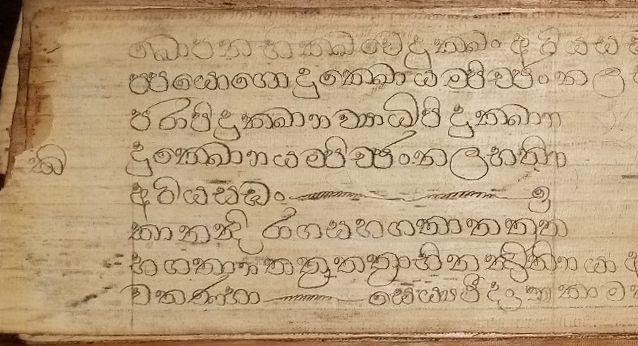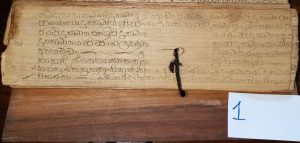More Leaves from a Deconstructed Sinhalese Palm-Leaf Manuscript
April 10, 2021 in Manuscript Studies
More Leaves of a Deconstructed
Sinhalese Palm-Leaf Manuscript
with Stringing Holes
Part 2

Private Collection, Sinhalese Palm-Leaf Manuscript, Leaf ’31’, Side 1, Detail: Left-hand Side. Reproduced by Permission.
[Posted on 10 April, with updates, as Mildred Budny continues the quest, and the owner supplies the full series of images.]
Following Part 1, we continue the display of the leaves — or rather bisected half-leaves — in a Sinhalese Palm-Leaf Manuscript now in a private collection. The fragment apparently presents a single Buddhist text, albeit in a disordered sequence with some gaps. The text is not yet identified.
The manuscript is written, from left to right, in Sinhalese script (see Sinhala_script) upon palm-leaves. The language is mostly likely Pali (a guide: Pali). At present, the 33 half-leaves are strung on string or cord through a single stringing hole, ending in a simple beveled rectangular cover. The text is written in single columns of 5 to 8 lines per column.
A match for the specimen in terms of script appears here, with transliteration of its text:
Some half-leaves have Letter/Number Marks in the left-hand margin. They correspond with one of the systems for Sinhala Numerals.
The Kaṭapayādi or Katapayadi System uses Sinhala consonants to depict Numbers 1 to 9 and 0, “for easy remembrance of numbers as words or verses”. The numeration “is known as Katapayadiya since number one is allocated with the Sinhala letters ‘Ka’ (ක), ‘Ta’ (ට), ‘Pa’ (ප ) and ‘Ya’ (ය)”.
Some archaic Sinhala Numerals are shown in A Comprehensive Grammar of Sinhalese Language by Mendis Gunasekera (1891), Plate III.

Mendia Gunesekera (1891), Plate III. Image via Creative Commons.
By such guides, as well as other material and textual features of the half-leaves, a conjectured reconstruction might be assembled.
A Full Leaf Reconstructed
An example, showing the full leaf on one of its sides, combines its fragmentary half-leaves photographically. Part 1 already showed one side. Now in Part 2 we show both.
One Side (30A + 26A Upright)

Private Collection, Sinhalese Palm-Leaf Manuscript, Reconstructed View of Former Leaf (’30A’ + 26A’).
The Other Side (30 + 26 Upright)

Private Collection, Sinhalese Palm-Leaf Book. Reconstructed View of Former Leaf (’30’ + 26′ upright). Reproduced by Permission.
A Case Study
The goal here is both:
- to show the book as a case study, or cautionary tale, for materials from foreign lands and languages, and
- to gather feedback and suggestions for reconstructing its original order, recognizing its text, and identifying its probable date and place of production.
You can join the quest even if you do not (yet) know the language, because material features and pattern recognition offer useful guides for solving the puzzle.
Part 1 considered:

Private Collection, Sinhalese Palm-Leaf Manuscript, End-Leaf 01, Left.
That first Post presented, with the owner’s permission, images of some leaves out of the full set in the book at present. The full set of images encompasses Sides 1–30A, plus the cover.
The numbering was adopted by the collector for photographing the half-leaves in their current series within the book. Numbers 1–30 for the leaves, and suffix A for their second sides: 1, 1A, 2, 2A, and so on. Let’s call them “Sides”. Note that the current assembly of the leaves, and the photographs made in consecutive sequence turning its leaves one by one, sometimes show the text on them upside-down.
The first post displayed images in several groups:
-
Beveled Rectangular Cover

Private Collection, Sinhalese Palm-Leaf Manuscript, Cover.
-
Numbers 1–8A
To Start the Show

Private Collection, Sinhalese Palm-Leaf Manuscript, End Leaf ’01a’ =Side 1.
-
Numbers 9–11A and 23–24A
To Exhibit the Half-Leaves which have Doubled (or Repierced) Sets of Stringing Holes

Private Collection, Sinhalese Palm-Leaf Manuscript, Leaf 9A.
-
Numbers 30A + 26A:
To Demonstrate the Virtual Reconstruction of the Originally Conjoined Halves of one Full Side (front or back) of a Single Leaf

Private Collection, Sinhalese Palm-Leaf Manuscript, Reconstructed View of Former Leaf (’30A’ + 26A’).
That virtual reconstruction of 1 former side of 1 full leaf vividly demonstrates the reshuffling of the half-leaves in producing a newly reconstructed ‘deck’ for the sequence.
Now we show more of the manuscript.
